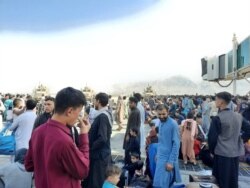Men with Kalashnikovs roamed the streets of Kabul on foot, in security vehicles and on motorcycles Monday as the insurgents solidified their hold on Afghanistan’s capital.
They seemed to have taken over the duties of Afghan police and security forces that were hardly visible anymore. Armed Taliban stood at the gates of the compound that led to the U.S. Embassy, now vacated. They also seemed to be standing guard outside the house of Abdullah Abdullah, head of the High Council for National Reconciliation.
At checkpoints previously staffed by Afghan forces, men with long beards wearing shalwar kameez — the long tunic and loose pants that make the local dress — AK-47s dangling at their side, looked inside car windows and asked drivers where they were going, sometimes with a smile and a hand raised to their chest as a gesture of respect.
On one road during a traffic jam, two Taliban got out of their vehicle to help break up a fight over a fender bender.
Taliban leadership had announced that the group was only entering the city to keep the peace and prevent looting, as reports emerged that police and security forces were abandoning their posts.
“The Islamic Emirate has ordered its mujahedeen and once again instructs them that no one is allowed to enter anyone's house without permission,” Taliban spokesman Suhail Shaheen said on Twitter. “Life, property and honor of none shall be harmed but must be protected by the mujahedeen.”
Still, many people told VOA they preferred to stay home until the situation became clearer. Almost all shops, offices and banks were closed on Monday. Traffic was light in a city famous for its traffic jams, except near the airport, where the VOA team witnessed scenes of mayhem.
Thousands of people were gathered, and the crowds were often rushing forward and then running back when members of the Taliban, trying to control the perimeter of the airport, pushed them back with long batons. Sounds of sporadic gunfire erupted in the air.
The rush at the airport and the strong push to get out was one indicator of people’s anxiety about life under the Taliban. Another was a change in the dress code. Most of the men were dressed in shalwar kameez. Hardly any wore jeans and T-shirts, a common sight a week ago.
The other big change from a week ago was the presence of women. On a normal day in Kabul, one could see a significant number of women on the streets dressed in jeans, long tunics and headscarves and full burqas.
Not now. The small group of women on the streets were fully covered in hijabs and wearing face masks to protect against the coronavirus.
While the Taliban promised there would be no violence against anyone, citizens of Kabul seemed to be treading cautiously, just in case.









